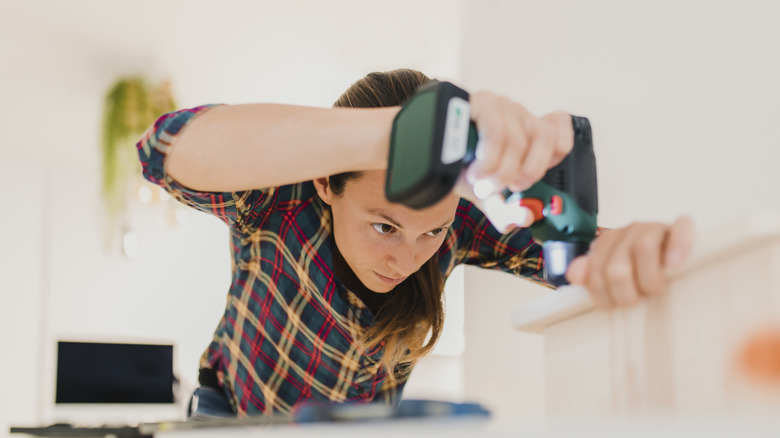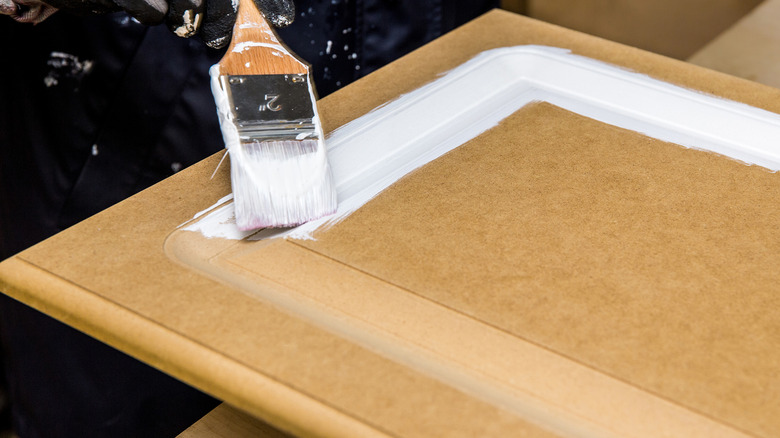Is A Heat Gun The Answer For A Kitchen Cabinet Transformation? Here's What We Know
If you have MDF cabinets with laminate paneling, you may have discovered some of the hidden downsides of putting laminate cabinets in your home, and unfortunately, upgrading kitchen cabinets can be expensive. Painting your cabinets is a great budget DIY to change things up, but laminate does not have a porous surface, making it difficult to paint. Luckily, there is a simple and effective way to remove laminate paneling from MDF cabinets.
When gently heated, the adhesive that secures the laminate to the MDF cabinets loosens, allowing you to peel the laminate off without harming the MDF underneath. If you decide to tackle this project, you will need some supplies and safety equipment to make it happen. Primarily, you will need a heat source. A heat gun works well, but many people also report success using a hairdryer with a high heat setting, and it is definitely worth testing out your hairdryer before purchasing a heat gun to save a bit of money. You will also need a screwdriver to remove any hardware from the cabinets, and some safety gear. To protect yourself from debris, you should wear gloves, goggles, and a dust mask. You might also need a putty knife and a utility knife to help you lift the adhesive and cut through it where needed.
How to remove laminate from MDF cabinets
The process for this DIY is quite simple. First, remove the doors and hardware from the cabinets. (While not strictly necessary, this can help make the process easier if you have space and want to avoid making a mess.) In small sections, use your hairdryer or heat gun to warm the laminate until it begins to separate from the MDF. Just remember that MDF can be damaged by heat, so if using a heat gun, keep it at a low heat level and limit the amount of time the heat is directed at one spot. As the laminate begins to separate, use the putty knife to peel and lift it to avoid burning your hands. If needed, you can use the utility knife to create places to insert the putty knife. The laminate may tear as you peel it off; if this happens, just heat the next area and slide the putty knife underneath to create more separation.
Also, use caution in areas where the laminate is tricky to remove. Working too quickly can result in the MDF chipping or breaking off, which can be difficult to repair. If the MDF does start coming off with the laminate, stop peeling that piece. This occurs when the adhesive is not warm enough, so direct more heat at the area before trying again. The laminate should peel off with little resistance. You can later repair the chipped spot with wood filler before painting.
How to paint MDF cabinets after removing the laminate
Once the laminate is removed, you can move on to painting your cabinets. You will need 120-grit and 220-grit sandpaper, a primer designed for use on MDF, paint, an enamel top coat, and an oil-based polyurethane. If you are looking for cabinet paint color inspiration, check out some of the timeless paint colors HGTV stars love using in kitchens. Start by sanding cabinet surfaces with the 120-grit sandpaper, then smooth them out with the 220-grit. If there was any damage to the MDF during the laminate removal process, fill the damaged areas with wood filler, wait for it to dry, and then sand it until it is even and smooth.
Next, apply your primer and let it dry completely before following up with paint; be sure to follow the directions on the primer's label. You will likely need at least two coats of paint. When the paint is dry, apply the enamel topcoat for extra durability, and finish up with a coat of oil-based polyurethane to seal the surfaces. If for whatever reason you're unable to remove your laminate, all is not lost. You might still be able to give your cabinets a colorful refresh by following these genius tips for painting laminate cabinets.

